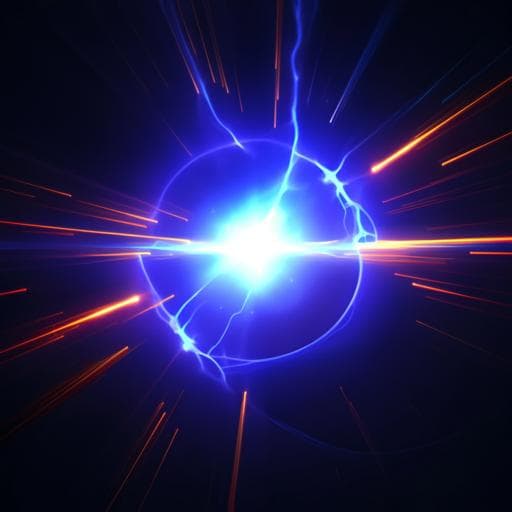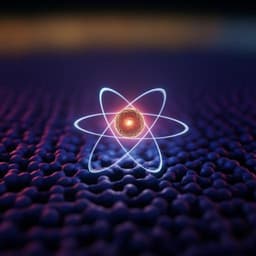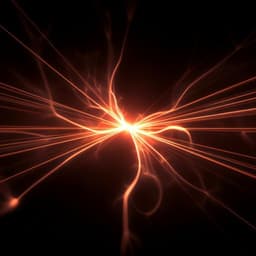
Physics
Demonstration of a compact plasma accelerator powered by laser-accelerated electron beams
T. Kurz, T. Heinemann, et al.
Discover groundbreaking advancements in plasma wakefield acceleration with research by T. Kurz, T. Heinemann, M. F. Gilljohann, and colleagues. This innovative study showcases a millimeter-scale plasma accelerator that achieves astounding 128 MeV electron acceleration. This compact accelerator holds the promise for high-brightness electron beam sources for applications such as free-electron lasers.
~3 min • Beginner • English
Introduction
The study investigates whether laser-wakefield accelerator (LWFA) generated electron beams can effectively drive plasma wakefield accelerators (PWFAs) in a compact, millimeter-scale setup. Traditional beam-driven PWFAs, which can preserve emittance and provide stable, high-gradient acceleration in the blowout regime, typically require kilometer-scale RF accelerators due to the need for high peak-current drivers. LWFAs now produce GeV-class, few-femtosecond electron beams with peak currents exceeding 10 kA, making them promising compact drivers for PWFAs at high plasma densities (>10^18 cm−3). A staged LWFA-driven PWFA (LPWFA) could combine the strengths of both schemes to generate ultra-short, ultra-low-emittance witness beams and serve as an accessible platform for fundamental PWFA studies and development of advanced injection schemes. The paper aims to unambiguously demonstrate beam-driven wakefield formation and witness acceleration powered solely by LWFA electron beams, using two separated gas jets to decouple LWFA and PWFA processes.
Literature Review
Background work establishes the blowout regime and its benefits for uniform focusing and low-energy-spread witness beams (Rosenzweig 1991; Lotov 2004; Tzoufras 2008). Access to suitable drivers has limited PWFA experiments to a few RF facilities (e.g., SLAC: Blumenfeld 2007; Litos 2014). LWFAs have achieved multi-GeV energies (Gonsalves 2019) and kiloampere peak currents (Li 2017; Couperus 2017; Lundh 2011), making them suitable PWFA drivers (Hidding 2010; Martinez de la Ossa 2015) with potential gradients >100 GV m−1 (Corde 2016). Laser-driven beams can be more resilient to driver instabilities (Mehrling 2017; Martinez de la Ossa 2018). Advanced injection schemes include ionization-based and density-ramp techniques (Hidding 2012; Martinez de la Ossa 2013; Li 2013; Wittig 2015; Martinez de la Ossa 2017; Zhang 2019), with auxiliary lasers enabling precise control (Deng 2019). Prior hybrid studies often relied on uncontrolled transitions via laser pump depletion (Corde 2011; Masson-Laborde 2014; Wu 2019). Optical diagnostics have enabled direct observation of beam-driven wakefields (Gilljohann 2019). The present work introduces a clearly separated two-stage LPWFA to isolate and study the beam-driven process.
Methodology
Two complementary LPWFA experiments were conducted at 100 TW-class, short-pulse laser facilities (DRACO at HZDR; ATLAS at LMU). In both, an LWFA stage generates a high-peak-current drive beam, which then enters a separate PWFA stage where a witness beam is accelerated.
- High-gradient LPWFA (HZDR/DRACO): A Ti:Sa laser (30 fs, 800 nm, 1.7 J on target, a0≈2.1) was focused with F/20 optics to a 19.5 µm FWHM spot (I0≈1×10^19 W cm−2). The LWFA stage used a 3 mm He gas jet doped with 3% N2 (self-truncated ionization-induced injection), with a ~1.6 mm flat-top density region and ~0.6 mm ramps, at plasma density 4–4.5×10^18 cm−3. The PWFA stage used a 3 mm H2 gas jet doped with 10% He at 3.5–4.2×10^18 cm−3, oriented orthogonally and directly adjacent (no vacuum gap). A 12.5 µm steel foil at the PWFA entrance reflected the spent LWFA laser while transmitting the electron beam. The PWFA operated in two modes: (i) self-ionized, where the beam field ionizes the gas, and (ii) pre-ionized, using a 20 mJ counter-propagating laser (~1 ps advance, f=1 m, ~120 µm FWHM focus, ~4×10^15 W cm−2) to fully ionize H and He prior to driver arrival. A few-cycle probe (9.2 fs, 0.4 mJ) provided side-imaging shadowgraphy of plasma wakefields. Electron spectra were measured with a 0.4 m, 0.9 T permanent magnet spectrometer and calibrated scintillating screens, with 2–550 MeV detection range and quantified readout uncertainties at high energies. Three-dimensional start-to-end PIC simulations (PIConGPU) modeled the measured laser mode content, gas profiles and mixtures, and a laser-blocking foil (implemented as 50× critical density), resolving the LWFA, foil reflection, and PWFA processes; OSIRIS simulations illustrated wake structures.
- Drive–witness bunch pair LPWFA (LMU/ATLAS): A Ti:Sa laser (28 fs, 2.5 J, ~80 TW, 800 nm) focused with F/25 optics to a 24 µm spot (I≈6.8×10^18 W cm−2). The LWFA stage used a 5 mm pure H2 supersonic jet with a shock-front injector (silicon wafer edge) at density 3.7×10^18 cm−3 to generate two bunches injected into the first and second wake cavities, forming a driver–witness pair with ~17 µm spacing (~one plasma wavelength). The PWFA stage was a 1 mm H2 jet at 1.4×10^18 cm−3 (and tested at 2.1×10^18 cm−3), separated by a 5.5–6 mm vacuum gap to reduce the residual laser below 1×10^17 W cm−2, effectively acting only as a pre-ionizer; no blocker foil was used. Electron detection employed a 0.8 m, 0.9 T spectrometer with absolutely calibrated CAWO OG16 screen and a pointing reference screen. Simulations with FBPIC modeled the LWFA generation of the dual-bunch and the subsequent vacuum transport plus PWFA interaction at measured divergences, showing negligible contribution of the laser remnant to wake excitation in the second stage and positioning of the witness at the accelerating phase by tuning the PWFA density.
Key Findings
- Clear beam-driven wakefield formation in a separated PWFA stage powered solely by LWFA electron beams was observed. Shadowgraphy in the self-ionized case showed a narrow ionized filament and a few plasma wake oscillations behind the driver; in the pre-ionized case, more than ten cavities were visible with a more pronounced wake structure, indicating stronger excitation.
- Witness acceleration: Distinct witness beams were observed in 28% (self-ionized) and 37% (pre-ionized) of shots. In the pre-ionized regime, the shot-averaged witness energy was 100 ± 5 MeV versus 62 ± 4 MeV in self-ionized operation. Maximum witness energy reached 128 MeV.
- Driver degradation vs witness gain: With both jets on, the driver spectral charge density dropped to ~one-third of the LWFA-only reference in the self-ionized case and to ~17% in the pre-ionized case, consistent with stronger energy transfer to the plasma and higher witness energies when pre-ionized. Correlation analysis confirmed higher witness energy with increased driver depletion.
- Effective accelerating gradient: Using a 1.5 mm acceleration distance and a conservative net witness energy increase of 66 MeV relative to the self-ionized sample, an effective gradient increase of ~50 GV m−1 was estimated for the pre-ionized case. Simulations indicated peak accelerating fields exceeding 100 GV m−1.
- Witness quality and efficiency: A representative pre-ionized witness (Fig. 2c) had ~6.0% energy spread, 3.8 mrad FWHM divergence, and 12 pC FWHM charge. The overall driver-to-witness energy transfer efficiency was 2.9%, about 5× higher than in previous RF-based PWFA demonstrations.
- PIC simulations (PIConGPU) reproduced a narrow-band LWFA driver with trailing low-energy electrons, laser-driven pre-foil energy gain, and purely beam-driven acceleration post-foil. The simulated witness comprised mainly trailing background electrons trapped in the PWFA wake and experienced >100 GV m−1 fields, achieving energies compatible with measurements.
- Drive–witness bunch pair LPWFA: Shock-front injection produced a driver–witness pair with average energies 244 ± 1 MeV (120 ± 5 pC) and 119 ± 1 MeV (36 ± 2 pC), respectively, separated by ~17 µm. In the PWFA stage at 1.4×10^18 cm−3, the driver mean energy decreased by ~5% and the witness was accelerated to 133 ± 1 MeV (gain ~14 MeV). Charge capture efficiency into the witness was ~70%, nearly an order of magnitude higher than prior RF-based PWFA results. At higher PWFA density (2.1×10^18 cm−3), stronger driver degradation and larger witness energy shift led to spectral overlap, illustrating tunability and robustness.
Discussion
The findings directly demonstrate that LWFA-generated electron beams can drive strong, beam-only plasma wakefields in a separate stage and efficiently accelerate a witness, validating the LPWFA concept as a compact alternative to RF-driven PWFAs. The use of a blocker foil or a vacuum gap decouples laser effects from the beam-driven process, enabling independent control of LWFA and PWFA stages. Pre-ionization of the PWFA medium significantly enhances wake excitation by allowing the full driver to interact with the plasma, leading to higher driver depletion and higher witness energies, as observed experimentally and supported by simulations. The measured effective gradient increase (~50 GV m−1) and simulated peak fields (>100 GV m−1) are comparable to gradients achieved at large RF facilities, while the energy transfer efficiency (2.9%) and, in the dual-bunch experiment, the charge capture efficiency (~70%) surpass prior RF-based PWFA benchmarks. The controlled drive–witness pair demonstrates precise phasing and tunability of the accelerating phase via plasma density, paving the way for advanced injection schemes and application-driven optimization. Overall, the results indicate that LPWFAs can serve both as compact, accessible testbeds for PWFA physics and as practical sources of high-brightness beams for demanding applications.
Conclusion
This work demonstrates a millimeter-scale plasma accelerator powered by LWFA electron beams, with clear evidence of beam-driven wakefield formation and witness acceleration. Pre-ionization of the PWFA stage enhances wake amplitude and witness energy, achieving a maximum of 128 MeV and an effective gradient increase of ~50 GV m−1, with energy transfer efficiency of 2.9%. A separate drive–witness pair experiment shows controlled phasing, witness energy gain to 133 MeV, and ~70% charge capture efficiency, underscoring the robustness and tunability of LPWFAs. Future directions include implementing tailored density ramps and active plasma lenses to preserve emittance and improve matching, optimizing blocker placement and materials, extending PWFA stage length toward driver depletion limits for higher energies, and deploying advanced internal injection schemes within the PWFA to produce ultra-high-brightness, ultra-low-emittance beams. Optimized LPWFA systems can act as energy and brightness transformers delivering multi-GeV, application-ready beams for compact free-electron lasers and other quality-demanding sources.
Limitations
- The experiments were not optimized for highest beam quality; the representative witness beam had relatively low charge and there were large shot-to-shot fluctuations in both driver degradation and witness energy.
- In the high-gradient experiment, interaction with the steel blocker foil increased the driver divergence by ~50%, potentially impacting transport and wake driving; the foil position and material could be further optimized.
- The effective accelerating gradient estimate is conservative and based on relative comparison to the self-ionized sample and an assumed 1.5 mm acceleration length.
- The PIConGPU simulation neglected scattering of low-energy electrons through the foil, possibly overestimating the fraction of trailing electrons forming the witness; additional experimental processes (e.g., shock-induced injection from the foil edge) may contribute.
- In the drive–witness pair study, the witness energy gain was intentionally kept small to avoid spectral overlap; higher-density operation led to merging spectra, complicating unambiguous separation without enhanced diagnostics.
Related Publications
Explore these studies to deepen your understanding of the subject.







